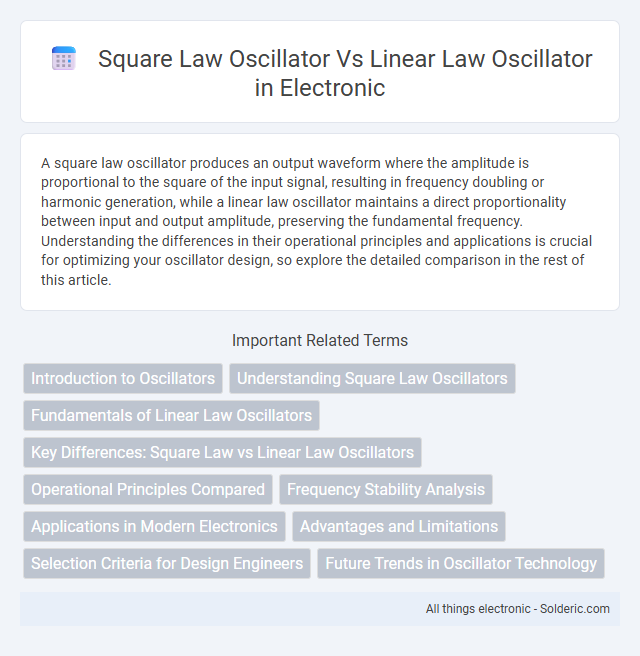A square law oscillator produces an output waveform where the amplitude is proportional to the square of the input signal, resulting in frequency doubling or harmonic generation, while a linear law oscillator maintains a direct proportionality between input and output amplitude, preserving the fundamental frequency. Understanding the differences in their operational principles and applications is crucial for optimizing your oscillator design, so explore the detailed comparison in the rest of this article.
Comparison Table
| Feature | Square Law Oscillator | Linear Law Oscillator |
|---|---|---|
| Operation Principle | Output proportional to square of input signal | Output proportional to linear (first power) of input signal |
| Waveform | Typically produces sinusoidal or harmonic waveforms | Generates sinusoidal waveforms with low distortion |
| Linearity | Non-linear characteristic due to squaring function | Highly linear response |
| Applications | Frequency multiplication, FM demodulation | Signal generation requiring stable frequency and low distortion |
| Complexity | Moderate, requires nonlinear elements | Simpler design with linear components |
| Frequency Stability | Moderate, affected by nonlinearities | High, due to linear operation |
| Phase Noise | Higher phase noise due to nonlinear components | Lower phase noise, better signal purity |
Introduction to Oscillators
Oscillators generate repetitive signals essential in electronic circuits, with Square Law oscillators producing waveforms based on nonlinear device characteristics resulting in stable amplitude but some harmonic distortion. Linear Law oscillators rely on linear components to produce sinusoidal outputs with low distortion and precise frequency control. Understanding these fundamental differences helps you choose the right oscillator type for applications requiring specific waveform purity and amplitude stability.
Understanding Square Law Oscillators
Square law oscillators generate sinusoidal waveforms by leveraging nonlinear components such as transistors or diodes, which produce output signals proportional to the square of the input voltage, enabling stable frequency generation. Unlike linear law oscillators that rely on linear feedback with proportional output, square law oscillators excel in frequency stability and distortion reduction, making them ideal for RF applications. Understanding the square law principle helps you optimize your oscillator design for improved signal purity and consistent amplitude control.
Fundamentals of Linear Law Oscillators
Linear law oscillators operate based on principles where the output voltage or current varies linearly with time, enabling stable frequency generation with minimal distortion. These oscillators rely on linear components like resistors, capacitors, and inductors, ensuring predictable oscillation behavior essential for communication and signal processing applications. Fundamental to their operation is the maintenance of phase shift and gain conditions defined by the Barkhausen criteria, which guarantees sustained sinusoidal oscillations without amplitude instability.
Key Differences: Square Law vs Linear Law Oscillators
Square law oscillators generate output signals based on the square of the input voltage, producing a non-linear response ideal for frequency multiplication and modulation applications. Linear law oscillators maintain a direct proportionality between input and output voltages, ensuring a stable and predictable sinusoidal waveform critical for signal generation and reference purposes. Your choice between these oscillators depends on whether you need harmonic-rich waveforms from square law characteristics or the consistent purity of linear oscillation.
Operational Principles Compared
Square law oscillators generate waveforms by exploiting nonlinear components, such as diodes or transistors, where the output voltage is proportional to the square of the input signal, leading to frequency multiplication or harmonic generation. Linear law oscillators operate based on the principle of linear feedback in amplifiers and resonant circuits, producing stable sinusoidal outputs at a fundamental frequency with minimal harmonic distortion. Your choice between these oscillators depends on the desired signal characteristics, where square law oscillators are preferred for generating harmonics, and linear law oscillators excel in producing pure sine waves for communication systems.
Frequency Stability Analysis
Square law oscillators exhibit frequency stability dependent on nonlinear device characteristics, often resulting in increased phase noise and frequency drift due to amplitude variations. Linear law oscillators maintain more consistent frequency stability by relying on linear feedback elements, minimizing distortion and enhancing predictable oscillation behavior. Your choice between these oscillator types significantly impacts the precision and reliability of frequency stability in communication and signal processing applications.
Applications in Modern Electronics
Square law oscillators generate signals with frequency dependent on the square of the input voltage, making them ideal for frequency modulation and signal processing in communication systems. Linear law oscillators produce output frequency proportional to the input voltage, offering precise control used in voltage-controlled oscillators (VCOs) for synthesizers and phase-locked loops in modern electronics. You can select between these oscillator types based on the specific modulation requirements and linearity needed for your electronic applications.
Advantages and Limitations
Square law oscillators offer enhanced amplitude stability and reduced distortion due to their nonlinear operation, making them ideal for frequency generation in communication systems. However, their complexity and sensitivity to component variations can lead to stability challenges and increased design difficulty. Linear law oscillators provide simpler circuit designs and predictable frequency behavior but often suffer from higher phase noise and reduced amplitude control compared to square law counterparts.
Selection Criteria for Design Engineers
Design engineers select square law oscillators for applications requiring stable frequency generation and minimal distortion in RF circuits due to their predictable non-linear characteristics and simplicity. Linear law oscillators are preferred when linearity and wide dynamic range are critical, such as in communication systems demanding precise amplitude control and low phase noise. The choice depends on factors like signal purity, harmonic content, power efficiency, and the specific frequency range requirements of the intended electronic design.
Future Trends in Oscillator Technology
Square law oscillators leverage nonlinear components to generate stable and efficient signals, while linear law oscillators utilize linear feedback for precision frequency control. Future trends indicate a growing integration of digital signal processing and microelectromechanical systems (MEMS) to enhance oscillator performance and miniaturization. Your choice between these oscillator types will influence adaptability to emerging applications like IoT devices and 5G communication systems.
Square law oscillator vs Linear law oscillator Infographic

 solderic.com
solderic.com